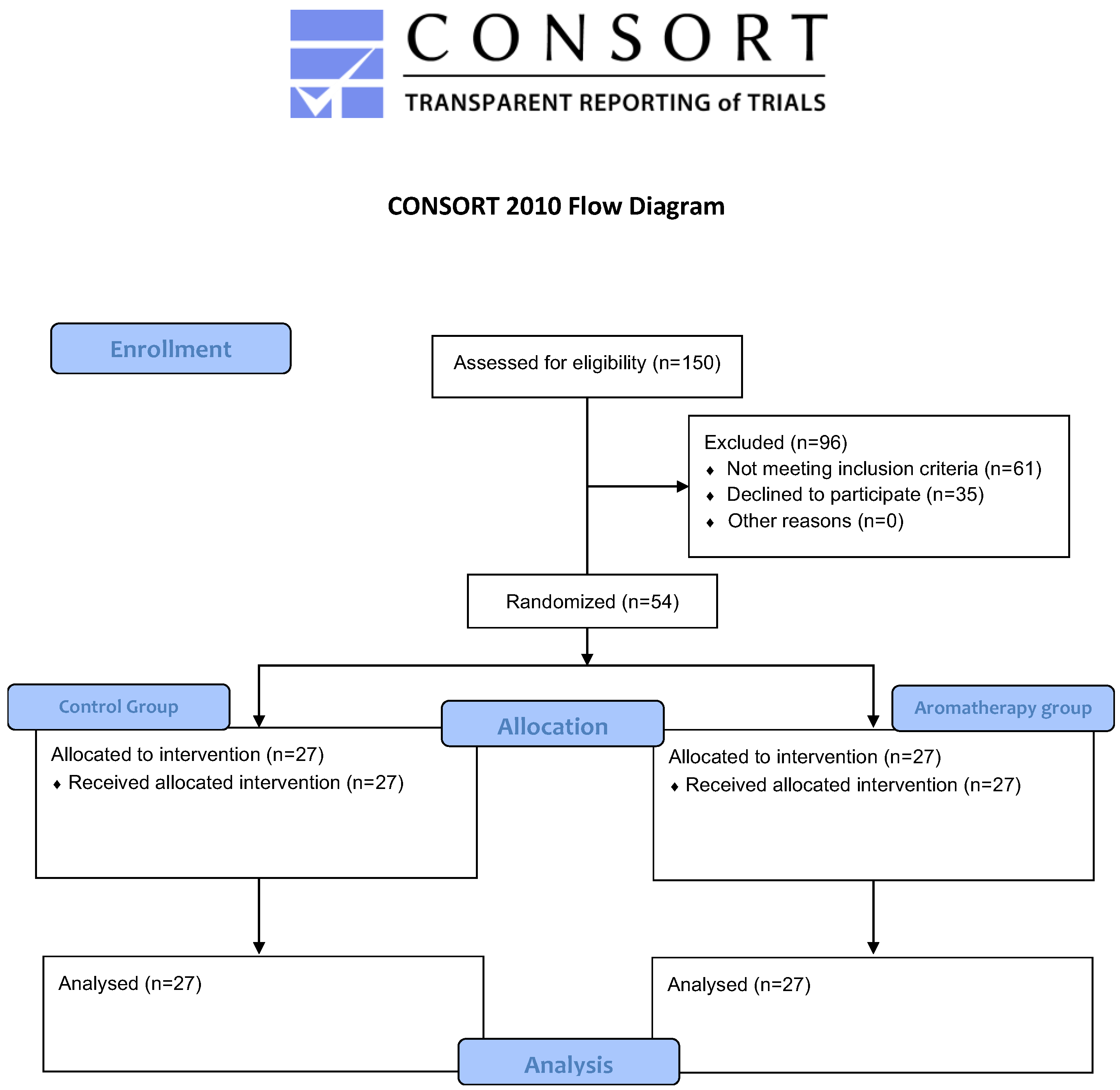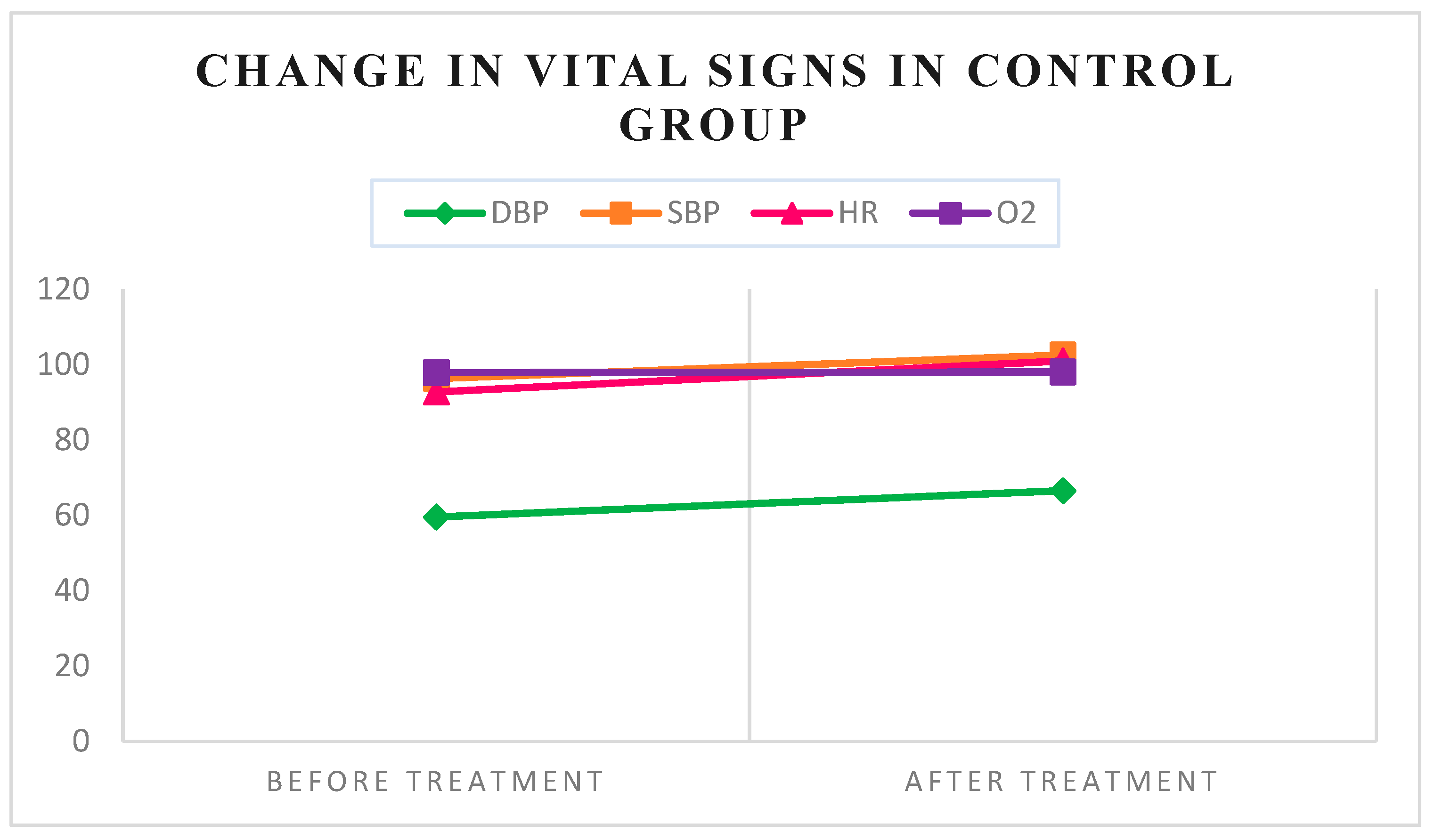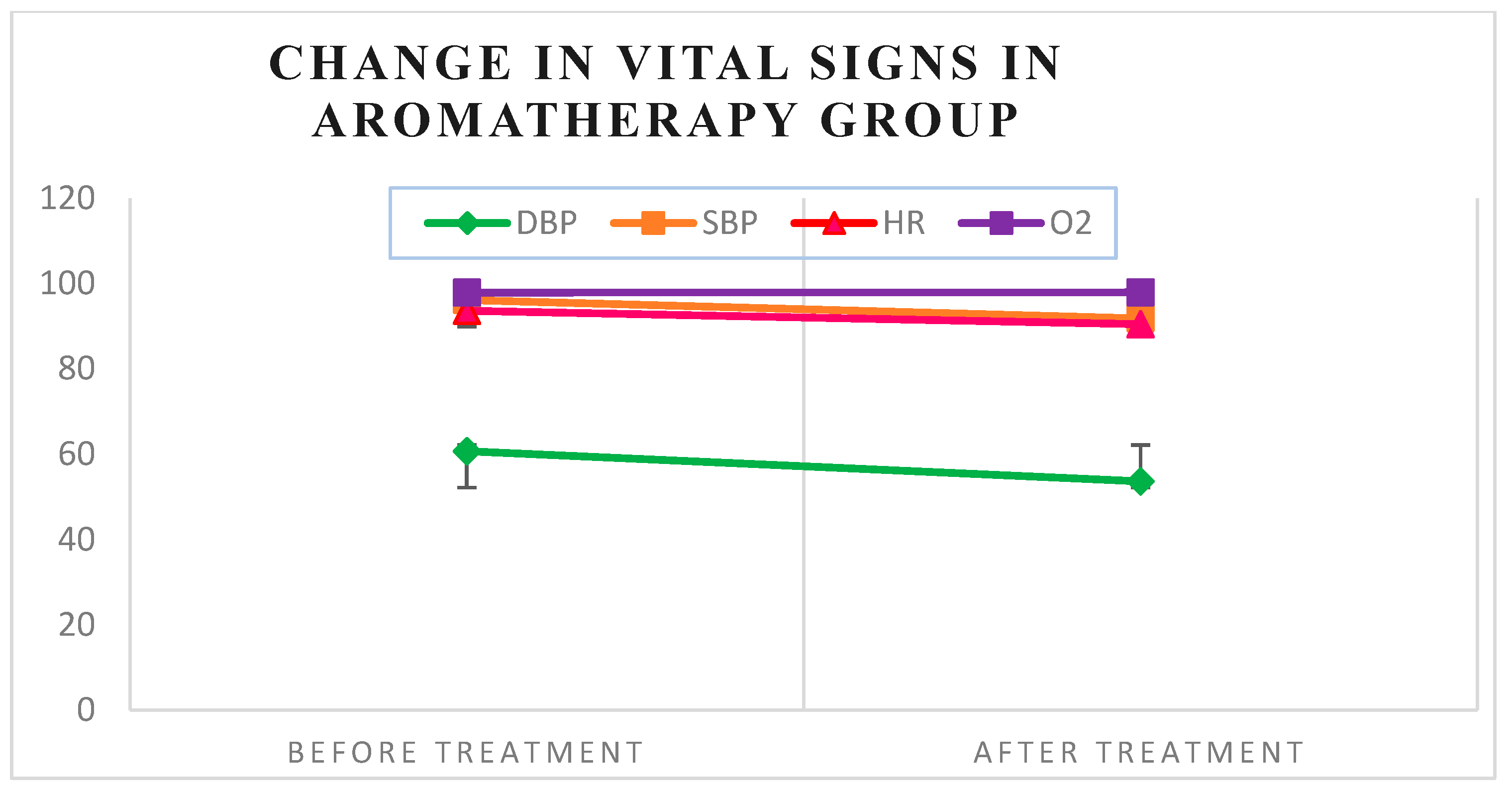Lavender–Neroli Aromatherapy for Reducing Dental Anxiety and Pain in Children During Anesthesia: A Two-Arm Randomized Controlled Trial
Abstract
1. Introduction
2. Materials and Methods
2.1. Study Design, Settings, and Ethical Approval
2.2. Sample Size Calculation
2.3. Recruitment and Eligibility Criteria
2.4. Randomization
2.5. Blinding
2.6. Intervention Procedures
2.7. Outcomes and Measurements
2.8. Statistical Analysis
3. Results
4. Discussion
5. Conclusions
Author Contributions
Funding
Institutional Review Board Statement
Informed Consent Statement
Data Availability Statement
Acknowledgments
Conflicts of Interest
References
- Grisolia, B.M.; Dos Santos, A.P.P.; Dhyppolito, I.M.; Buchanan, H.; Hill, K.; Oliveira, B.H. Prevalence of dental anxiety in children and adolescents globally: A systematic review with meta-analyses. Int. J. Paediatr. Dent. 2021, 31, 168–183. [Google Scholar] [CrossRef] [PubMed]
- Crellin, D.J.; Harrison, D.; Santamaria, N.; Huque, H.; Babl, F.E. The Psychometric Properties of the FLACC Scale Used to Assess Procedural Pain. J. Pain 2018, 19, 862–872. [Google Scholar] [CrossRef] [PubMed]
- Shukla, H.; Kulkarni, S.; Wasnik, M.B.; Rojekar, N.; Bhattad, D.; Kolekar, P. Acceptance of Parents for Behavior Management Technique with Reference to Previous Dental Expertise and Dental Anxiety. Int. J. Clin. Pediatr. Dent. 2021, 14 (Suppl. 2), S193–S198. [Google Scholar] [CrossRef] [PubMed] [PubMed Central]
- Shindova, M.P.; Belcheva, A.B. Dental fear and anxiety in children: A review of the environmental factors. Folia Med. 2021, 63, 177–182. [Google Scholar] [CrossRef] [PubMed]
- Appukuttan, D.P. Strategies to manage patients with dental anxiety and dental phobia: Literature review. Clin. Cosmet. Investig. Dent. 2016, 8, 35–50. [Google Scholar] [CrossRef] [PubMed] [PubMed Central]
- Zinke, A.; Hannig, C.; Berth, H. Comparing oral health in patients with different levels of dental anxiety. Head Face Med. 2018, 14, 25. [Google Scholar] [CrossRef] [PubMed] [PubMed Central]
- Seangpadsa, K.; Smutkeeree, A.; Leelataweewud, P. Parental acceptance of behavior management techniques for preschool children in dental practice: Revisited. J. Indian Soc. Pedod. Prev. Dent. 2020, 38, 274–279. [Google Scholar] [CrossRef] [PubMed]
- Coté, C.J.; Wilson, S. Guidelines for Monitoring and Management of Pediatric Patients Before, During, and After Sedation for Diagnostic and Therapeutic Procedures. Pediatr. Dent. 2019, 41, 259–260. [Google Scholar] [CrossRef] [PubMed]
- Bikmoradi, A.; Khaleghverdi, M.; Seddighi, I.; Moradkhani, S.; Soltanian, A.; Cheraghi, F. Effect of inhalation aromatherapy with lavender essence on pain associated with intravenous catheter insertion in preschool children: A quasi-experimental study. Complement. Ther. Clin. Pract. 2017, 28, 85–91. [Google Scholar] [CrossRef] [PubMed]
- Moslemi, F.; Alijaniha, F.; Naseri, M.; Kazemnejad, A.; Charkhkar, M.; Heidari, M.R. Citrus aurantium Aroma for Anxiety in Patients with Acute Coronary Syndrome: A Double-Blind Placebo-Controlled Trial. J. Altern. Complement. Med. 2019, 25, 833–839. [Google Scholar] [CrossRef] [PubMed]
- Reyes, M.C.G.M.; Reyes, M.C.G.M.; Ribay, K.G.L.; Paragas, E.D., Jr. Effects of sweet orange aromatherapy on pain and anxiety during needle insertion among patients undergoing hemodialysis: A quasi-experimental study. Nurs. Forum. 2020, 55, 425–432. [Google Scholar] [CrossRef] [PubMed]
- Ali, B.; Al-Wabel, N.A.; Shams, S.; Ahamad, A.; Khan, S.A.; Anwar, F. Essential oils used in aromatherapy: A systemic review. Asian Pac. J. Trop. Biomed. 2015, 5, 601–611. [Google Scholar] [CrossRef]
- Alkanan, S.A.M.; Alhaweri, H.S.; Khalifa, G.A.; Ata, S.M.S. Dental pain perception and emotional changes: On the relationship between dental anxiety and olfaction. BMC Oral Health 2023, 23, 175. [Google Scholar] [CrossRef] [PubMed] [PubMed Central]
- Wang, Z.J.; Heinbockel, T. Essential Oils and Their Constituents Targeting the GABAergic System and Sodium Channels as Treatment of Neurological Diseases. Molecules 2018, 23, 1061. [Google Scholar] [CrossRef] [PubMed] [PubMed Central]
- Michalak, M. Aromatherapy and methods of applying essential oils. Arch. Physiother. Glob. Res. 2018, 22, 25–31. [Google Scholar]
- Lv, X.N.; Liu, Z.J.; Zhang, H.J.; Tzeng, C.M. Aromatherapy and the central nerve system (CNS): Therapeutic mechanism and its associated genes. Curr. Drug Targets 2013, 14, 872–879. [Google Scholar] [CrossRef] [PubMed]
- Wajda, M.; Gover, A.; Franco, L.; Blanck, T. Review of Lavender Aromatherapy: Past, Present, and Future. Austin Ther. 2017, 4, 1029. [Google Scholar]
- Donelli, D.; Antonelli, M.; Bellinazzi, C.; Gensini, G.F.; Firenzuoli, F. Effects of lavender on anxiety: A systematic review and meta-analysis. Phytomedicine 2019, 65, 153099. [Google Scholar] [CrossRef] [PubMed]
- Scandurra, C.; Mezzalira, S.; Cutillo, S.; Zapparella, R.; Statti, G.; Maldonato, N.M.; Locci, M.; Bochicchio, V. The Effectiveness of Neroli Essential Oil in Relieving Anxiety and Perceived Pain in Women during Labor: A Randomized Controlled Trial. Healthcare 2022, 10, 366. [Google Scholar] [CrossRef] [PubMed] [PubMed Central]
- Mannucci, C.; Calapai, F.; Cardia, L.; Inferrera, G.; D’Arena, G.; Di Pietro, M.; Navarra, M.; Gangemi, S.; Ventura Spagnolo, E.; Calapai, G. Clinical Pharmacology of Citrus aurantium and Citrus sinensis for the Treatment of Anxiety. Evid.-Based Complement. Altern. Med. 2018, 2018, 3624094. [Google Scholar] [CrossRef]
- Venkataramana, M.; Pratap, K.V.N.R.; Padma, M.; Kalyan, S.; Reddy, A.A.; Sandhya, P. Effect of aromatherapy on dental patient anxiety: A randomized controlled trial. J. Indian Assoc. Public Health Dent. 2016, 14, 131–134. [Google Scholar] [CrossRef]
- Zabirunnisa, M.; Gadagi, J.S.; Gadde, P.; Myla, N.; Koneru, J.; Thatimatla, C. Dental patient anxiety: Possible deal with Lavender fragrance. J. Res. Pharm. Pract. 2014, 3, 100–103. [Google Scholar] [CrossRef] [PubMed] [PubMed Central]
- Arslan, I.; Aydinoglu, S.; Karan, N.B. Can lavender oil inhalation help to overcome dental anxiety and pain in children? A randomized clinical trial. Eur. J. Pediatr. 2020, 179, 985–992. [Google Scholar] [CrossRef] [PubMed]
- Nirmala, K.; Kamatham, R. Effect of Aromatherapy on Dental Anxiety and Pain in Children Undergoing Local Anesthetic Administrations: A Randomized Clinical Trial. J. Caring Sci. 2021, 10, 111–120. [Google Scholar] [CrossRef] [PubMed] [PubMed Central]
- Jafarzadeh, M.; Arman, S.; Pour, F.F. Effect of aromatherapy with orange essential oil on salivary cortisol and pulse rate in children during dental treatment: A randomized controlled clinical trial. Adv. Biomed. Res. 2013, 2, 10. [Google Scholar] [CrossRef] [PubMed] [PubMed Central]
- Soni, S.; Bhatia, R.; Oberoi, J. Evaluation of the efficacy of aromatherapy on anxiety level among pediatric patients in a dental setting: A randomized control trial. Int. J. Oral Care Res. 2018, 6, 44–49. [Google Scholar]
- Ghaderi, F.; Solhjou, N. The Effects of Lavender Aromatherapy on Stress and Pain Perception in Children during Dental Treatment: A Randomized Clinical Trial. Complement. Ther. Clin. Pract. 2020, 40, 101182. [Google Scholar] [CrossRef]
- Abdalhai, R.; Kouchaji, C.; Alkhatib, R. The effect of aromatherapy with Lavender-Neroli oil and music in management of pediatric dental anxiety: A randomized control trial. BDJ Open 2024, 10, 5. [Google Scholar] [CrossRef]
- Pradopo, S.; Sinaredi, B.R.; Januarisca, B.V. Pandan Leaves (Pandanus Amaryllifolius) aromatherapy and relaxation music to reduce dental anxiety of pediatric patients. J. Int. Dent. Med. Res. 2017, 10, 933–937. [Google Scholar]
- McHugh, M.L. Interrater reliability: The kappa statistic. Biochem. Med. 2012, 22, 276–282. [Google Scholar] [CrossRef] [PubMed] [PubMed Central]
- Dean, J.A. Mcdonald and Avery’s Dentistry for the Child and Adolescent, 11th ed.; Dean, J.A., Ed.; Elsevier Health Scienc: Amsterdam, The Netherlands, 2021; pp. 327–330. [Google Scholar]
- Tiwari, S.; Kulkarni, P.; Agrawal, N.; Mali, S.; Kale, S.; Jaiswal, N. Dental Anxiety Scales Used in Pediatric Dentistry: A Systematic Review and Meta-analysis. J. Contemp. Dent. Pract. 2021, 22, 1338–1345. [Google Scholar] [PubMed]
- Fathima, F.; Jeevanandan, G. Validation of a facial image scale to assess child dental anxiety. Drug Invent. Today 2018, 10, 2825–2828. [Google Scholar]
- Dak Albab, R.; Shakhashero, H.; Al-Monaqel, M.B. The Validity and Reliability of the Arabic Version of FLACC Scale: A Clinical Trial. J. Anesth. Clin. Res. 2016, 7, 1–5. [Google Scholar] [CrossRef]
- Aditya, P.V.A.; Prasad, M.G.; Nagaradhakrishna, A.; Raju, N.S.; Babu, D.N. Comparison of effectiveness of three distraction techniques to allay dental anxiety during inferior alveolar nerve block in children: A randomized controlled clinical trial. Heliyon 2021, 7, e08092. [Google Scholar] [CrossRef] [PubMed]
- Al-Halabi, M.N.; Bshara, N.; AlNerabieah, Z. Effectiveness of audio visual distraction using virtual reality eyeglasses versus tablet device in child behavioral management during inferior alveolar nerve block. Anaesth. Pain Intensive Care 2018, 22, 55–61. [Google Scholar]
- Dixit, U.; Jasani, R. Comparison of the effectiveness of Bach flower therapy and music therapy on dental anxiety in pediatric patients: A randomized controlled study. J. Indian Soc. Pedod. Prev. Dent. 2020, 38, 71–78. [Google Scholar] [CrossRef] [PubMed]
- Koyande, A.P.; Pathivada, L.; Krishna, K.M.; Shukla, V.; Singh, A.; Samnani, N.J. Comparative Evaluation of Acupressure, Aromatherapy, and Stress Ball Efficacy in Reduction of Anxiety Levels in Children during Prophylactic and Restorative Procedures. Int. J. Clin. Pediatr. Dent. 2025, 18, 210–214. [Google Scholar] [CrossRef] [PubMed] [PubMed Central]
- O’Flaherty, L.A.; van Dijk, M.; Albertyn, R.; Millar, A.; Rode, H. Aromatherapy massage seems to enhance relaxation in children with burns: An observational pilot study. Burns 2012, 38, 840–845. [Google Scholar] [CrossRef] [PubMed]
- Maurya, A.; Prasad, J.; Das, S.; Dwivedy, A.K. Essential Oils and Their Application in Food Safety. Front. Sustain. Food Syst. 2021, 5, 653420. [Google Scholar] [CrossRef]
- Guo, P.; Li, P.; Zhang, X.; Liu, N.; Wang, J.; Yang, S.; Yu, L.; Zhang, W. The effectiveness of aromatherapy on preoperative anxiety in adults: A systematic review and meta-analysis of randomized controlled trials. Int. J. Nurs. Stud. 2020, 111, 103747. [Google Scholar] [CrossRef]
- Harada, H.; Kashiwadani, H.; Kanmura, Y.; Kuwaki, T. Linalool Odor-Induced Anxiolytic Effects in Mice. Front. Behav. Neurosci. 2018, 12, 241. [Google Scholar] [CrossRef] [PubMed] [PubMed Central]
- Eddin, L.B.; Jha, N.K.; Meeran, M.F.N.; Kesari, K.K.; Beiram, R.; Ojha, S. Neuroprotective Potential of Limonene and Limonene Containing Natural Products. Molecules 2021, 26, 4535. [Google Scholar] [CrossRef] [PubMed] [PubMed Central]
- Hyde, J.; Ryan, K.M.; Waters, A.M. Psychophysiological Markers of Fear and Anxiety. Curr. Psychiatry Rep. 2019, 21, 56. [Google Scholar] [CrossRef]
- Malcolm, B.J.; Tallian, K. Essential oil of lavender in anxiety disorders: Ready for prime time? Ment. Health Clin. 2018, 7, 147–155. [Google Scholar] [CrossRef] [PubMed] [PubMed Central]
- Nwosu, A.D.G.; Ossai, E.N.; Onwuasoigwe, O.; Ahaotu, F. Oxygen saturation and perceived discomfort with face mask types, in the era of COVID-19: A hospital-based cross-sectional study. Pan Afr. Med. J. 2021, 39, 203. [Google Scholar] [CrossRef] [PubMed] [PubMed Central]
- Raglio, A. A noval music-based theraeutic approach: The therapeutic music listening. Front. Hum. Nerousci. 2023, 17, 1204593. [Google Scholar] [CrossRef] [PubMed]
- Toet, A.; Smeets, M.A.; van Dijk, E.; Dijkstra, D.; van den Reijen, L. Effects of Pleasant Ambient Fragrances on Dental Fear: Comparing Apples and Oranges. Chemosens. Percept. 2010, 3, 182–189. [Google Scholar] [CrossRef] [PubMed] [PubMed Central]
- van der Weijden, F.N.; Hussain, A.M.; Tang, L.; Slot, D.E. The effect of playing background music during dental treatment on dental anxiety and physiological parameters: A systematic review and meta-analysis. Psychol. Music 2022, 50, 365–388. [Google Scholar] [CrossRef]
- Nord, D.; Belew, J. Effectiveness of the essential oils lavender and ginger in promoting children’s comfort in a perianesthesia setting. J. Perianesth Nurs. 2009, 24, 307–312. [Google Scholar] [CrossRef] [PubMed]
- Attar, R.H.; Baghdadi, Z.D. Comparative efficacy of active and passive distraction during restorative treatment in children using an iPad versus audiovisual eyeglasses: A randomised controlled trial. Eur. Arch. Paediatr. Dent. 2015, 16, 1–8. [Google Scholar] [CrossRef] [PubMed]
- Baghdadi, Z.D. Evaluation of audio analgesia for restorative care in children treated using electronic dental anesthesia. J. Clin. Pediatr. Dent. 2000, 25, 9–12. [Google Scholar] [PubMed]
- Baghdadi, Z.D. Evaluation of electronic dental anesthesia in children. Oral Surg. Oral Med. Oral Pathol. Oral Radiol. Endod. 1999, 88, 418–423. [Google Scholar] [CrossRef] [PubMed]




| Groups | Age | Gender | |||
|---|---|---|---|---|---|
| Min | Max | Means ± SD | Boys (n%) | Girls (n%) | |
| Aromatherapy group | 6 | 11 | 8.1 ± 1.5 | 15 (44.44%) | 12 (55.65%) |
| Control group | 6 | 10 | 8.2 ± 1.3 | 12 (55.65%) | 15 (44.44%) |
| Variables | Before Treatment | After Treatment | After-Before Mean Differences ± SD | p-Value | |
|---|---|---|---|---|---|
| Control group | FIS * | 58.34 | 79.88 | 0.000 S | |
| DBP $ | 59.57 ± 11.59 | 66.61 ± 16.31 | 7.04 ± 15.57 | 0.024 S | |
| SBP $ | 96.36 ± 9.97 | 102.61 ± 11.33 | 6.25 ± 10.46 | 0.004 S | |
| HR $ | 92.79 ± 15.76 | 101.04 ± 19.43 | 8.25 ± 10.17 | 0.000 S | |
| SPO2 $ | 97.93 ± 1.09 | 98.11 ± 1.13 | 0.18 ± 1.33 | 0.485 | |
| Aromatherapy group | FIS * | 55.11 | 51.7 | 0.6 | |
| DBP $ | 60.7 ± 12.07 | 53.67 ± 10.34 | −7.04 ± 13.32 | 0.011 S | |
| SBP $ | 96.11 ± 13.46 | 91.81 ± 12.57 | −4.30 ± 13.47 | 0.109 | |
| HR $ | 93.63 ± 16.83 | 90.48 ± 17.11 | −3.15 ± 7.69 | 0.043 S | |
| O2 $ | 97.85 ± 1.61 | 97.93 ± 1.33 | 0.07 ± 1.44 | 0.791 |
| Before Anesthesia | After Anesthesia | |||||
|---|---|---|---|---|---|---|
| Variables | Control Group | Aromatherapy Group | p-Value | Control Group | Aromatherapy Group | p-Value |
| FIS * | 58.34 | 55.11 | 0.916 | 79.88 | 51.7 | 0.001 S |
| DBP $ | 59.57 ± 11.59 | 60.7 ± 12.07 | 0.182 | 66.61 ± 16.31 | 53.67 ± 10.34 | 0.013 S |
| SBP $ | 96.36 ± 9.97 | 96.11 ± 13.46 | 1.00 | 102.61 ± 11.33 | 91.81 ± 12.57 | 0.038 S |
| HR $ | 92.79 ± 15.76 | 93.63 ± 16.83 | 0.825 | 101.04 ± 19.43 | 90.48 ± 17.11 | 0.000 S |
| SPO2 $ | 98.07 ± 1.24 | 97.85 ± 1.61 | 0.563 | 98.11 ± 1.13 | 97.93 ± 1.33 | 0.744 |
| FLACC $ | ----- | ----- | ----- | 3.11 ± 2.42 | 1.51 ± 1.87 | 0.042 S |
Disclaimer/Publisher’s Note: The statements, opinions and data contained in all publications are solely those of the individual author(s) and contributor(s) and not of MDPI and/or the editor(s). MDPI and/or the editor(s) disclaim responsibility for any injury to people or property resulting from any ideas, methods, instructions or products referred to in the content. |
© 2025 by the authors. Licensee MDPI, Basel, Switzerland. This article is an open access article distributed under the terms and conditions of the Creative Commons Attribution (CC BY) license (https://creativecommons.org/licenses/by/4.0/).
Share and Cite
Abdalhai, R.; Tolibah, Y.A.; Alkhatib, R.; Kouchaji, C.; Baghdadi, Z.D. Lavender–Neroli Aromatherapy for Reducing Dental Anxiety and Pain in Children During Anesthesia: A Two-Arm Randomized Controlled Trial. Med. Sci. 2025, 13, 166. https://doi.org/10.3390/medsci13030166
Abdalhai R, Tolibah YA, Alkhatib R, Kouchaji C, Baghdadi ZD. Lavender–Neroli Aromatherapy for Reducing Dental Anxiety and Pain in Children During Anesthesia: A Two-Arm Randomized Controlled Trial. Medical Sciences. 2025; 13(3):166. https://doi.org/10.3390/medsci13030166
Chicago/Turabian StyleAbdalhai, Rama, Yasser Alsayed Tolibah, Racha Alkhatib, Chaza Kouchaji, and Ziad D. Baghdadi. 2025. "Lavender–Neroli Aromatherapy for Reducing Dental Anxiety and Pain in Children During Anesthesia: A Two-Arm Randomized Controlled Trial" Medical Sciences 13, no. 3: 166. https://doi.org/10.3390/medsci13030166
APA StyleAbdalhai, R., Tolibah, Y. A., Alkhatib, R., Kouchaji, C., & Baghdadi, Z. D. (2025). Lavender–Neroli Aromatherapy for Reducing Dental Anxiety and Pain in Children During Anesthesia: A Two-Arm Randomized Controlled Trial. Medical Sciences, 13(3), 166. https://doi.org/10.3390/medsci13030166







